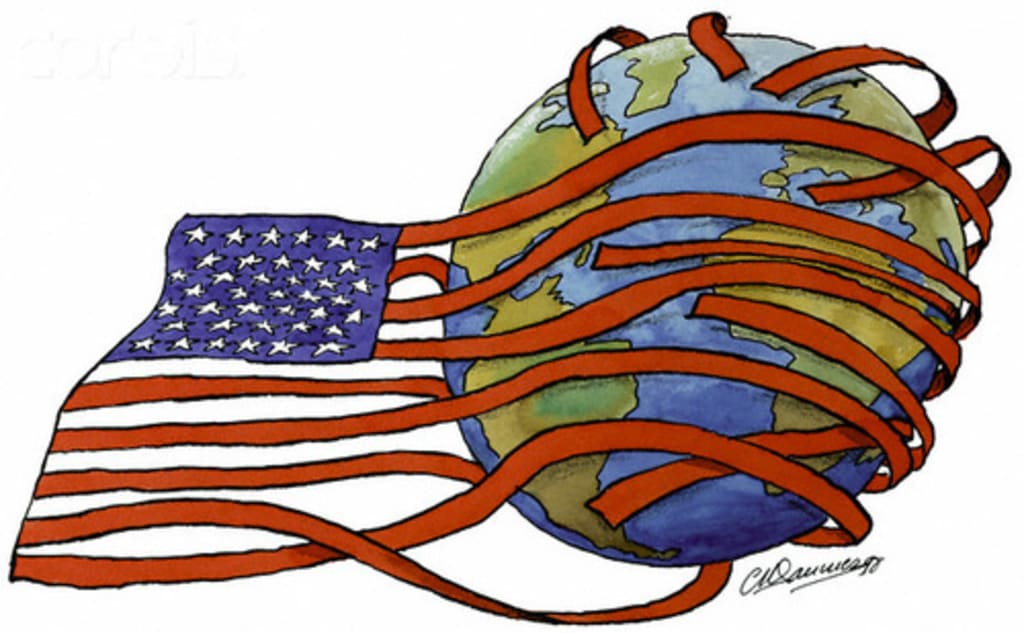From Colonies to Global Dominance: The Evolution of America as a Superpower
The Rise of a Superpower: How America Became a Global Leader

## The Rise of a Superpower: How America Became a Global Leader
The story of the United States' rise to global prominence is one of remarkable transformation. From a collection of thirteen colonies on the eastern seaboard to a dominant superpower with unparalleled economic, military, and cultural influence, America's ascent was driven by a combination of strategic decisions, visionary leadership, technological innovation, and a series of historical events that propelled the nation onto the world stage. This article explores the key factors and milestones that contributed to America's emergence as a superpower.
### Colonial Foundations and Early Expansion
The seeds of American power were sown during the colonial period. The British colonies in North America benefited from the mercantilist policies of the British Empire, which provided a steady flow of resources and protection. The geographic diversity of the colonies fostered a range of economic activities, from agriculture and fishing in the New England colonies to tobacco and cotton plantations in the South.
The American Revolution (1775-1783) marked the first significant step toward the nation's rise. The successful rebellion against British rule demonstrated the colonies' determination and ability to organize a cohesive military effort. The Treaty of Paris in 1783 recognized American independence and granted the new nation control over territory stretching from the Atlantic coast to the Mississippi River.
### The Industrial Revolution and Economic Growth
The 19th century was a period of rapid industrialization and economic expansion for the United States. The Industrial Revolution, which began in Britain, soon spread to America, transforming the nation's economy from agrarian to industrial. Key innovations, such as the cotton gin, steam engine, and telegraph, revolutionized production and communication.
The construction of the transcontinental railroad in the 1860s facilitated westward expansion and the integration of national markets. This period also saw the rise of influential entrepreneurs like John D. Rockefeller, Andrew Carnegie, and J.P. Morgan, whose ventures in oil, steel, and finance laid the foundation for America's economic might. The establishment of a robust banking system and the development of financial markets in cities like New York further solidified the nation's economic base.
### Territorial Expansion and Manifest Destiny
The concept of Manifest Destiny—the belief that the United States was destined to expand across the North American continent—played a crucial role in America's rise. This ideology justified territorial expansion and was a driving force behind key events such as the Louisiana Purchase (1803), the annexation of Texas (1845), and the acquisition of territories following the Mexican-American War (1846-1848).
The discovery of gold in California in 1848 spurred the Gold Rush, attracting a wave of settlers and leading to the rapid development of the western territories. The Homestead Act of 1862, which granted free land to settlers willing to cultivate it, further encouraged westward migration and the establishment of new states.
### The Civil War and National Unity
The Civil War (1861-1865) was a pivotal moment in American history. The conflict tested the durability of the United States as a unified nation. The victory of the Union forces not only preserved the nation but also led to the abolition of slavery, paving the way for a more just and equitable society.
The post-war period, known as Reconstruction, saw significant efforts to rebuild the South and integrate formerly enslaved people into American society. While the era was marked by considerable challenges and setbacks, it also set the stage for future civil rights advancements.
### Emergence on the World Stage
By the late 19th and early 20th centuries, the United States had established itself as a formidable economic power. The Spanish-American War of 1898 marked America's emergence as an international actor. The war resulted in the acquisition of territories such as Puerto Rico, Guam, and the Philippines, signaling a shift toward a more interventionist foreign policy.
Theodore Roosevelt's presidency (1901-1909) further solidified America's global presence. Roosevelt's "Big Stick" diplomacy and the construction of the Panama Canal (completed in 1914) enhanced the nation's strategic capabilities and facilitated global trade. The United States also played a key role in mediating international conflicts, exemplified by Roosevelt's involvement in negotiating the end of the Russo-Japanese War, for which he won the Nobel Peace Prize.
### World War I and the Interwar Period
World War I (1914-1918) was a turning point for the United States' role in global affairs. Initially adopting a stance of neutrality, America eventually entered the conflict in 1917, providing crucial support to the Allied powers. The war effort bolstered American industry and demonstrated the nation's military potential.
In the aftermath of World War I, the United States emerged as a leading economic power. The 1920s, often referred to as the "Roaring Twenties," were marked by significant economic growth and cultural dynamism. However, this period of prosperity came to an abrupt end with the onset of the Great Depression in 1929, which had profound effects on the global economy.
### World War II and the Birth of the Superpower
World War II (1939-1945) was the definitive event that established the United States as a superpower. The attack on Pearl Harbor in 1941 prompted America's full-scale entry into the war. The nation mobilized its vast industrial capacity, producing an unprecedented amount of military equipment and supplies. The war effort not only led to the defeat of the Axis powers but also propelled the United States to the forefront of global politics.
The post-war period saw the United States taking a leading role in establishing a new international order. The creation of the United Nations, the Marshall Plan for the reconstruction of Europe, and the establishment of institutions like the International Monetary Fund (IMF) and the World Bank were pivotal in shaping the post-war world. America's economic and military strength, coupled with its political influence, positioned it as a dominant global power.
### The Cold War Era
The Cold War (1947-1991) between the United States and the Soviet Union defined the latter half of the 20th century. This ideological and geopolitical struggle shaped American foreign and domestic policies. The United States adopted a strategy of containment to prevent the spread of communism, leading to involvement in conflicts such as the Korean War and the Vietnam War.
During this period, the United States also made significant advancements in science and technology. The space race culminated in the Apollo 11 moon landing in 1969, demonstrating America's technological prowess. The development of nuclear weapons and the establishment of a strong military-industrial complex further solidified the nation's superpower status.
### Economic and Cultural Influence
America's economic dominance continued to grow in the post-war era. The development of a consumer-oriented economy, driven by innovations in manufacturing, technology, and marketing, made American products and cultural exports ubiquitous around the world. The rise of multinational corporations, the spread of American media and entertainment, and the global appeal of American culture all contributed to the nation's influence.
The United States also played a central role in shaping global trade and finance. The establishment of the Bretton Woods system, which pegged international currencies to the U.S. dollar, underscored America's economic leadership. The nation's financial markets, particularly Wall Street, became critical centers for global investment and capital flow.
### The End of the Cold War and the Unipolar Moment
The dissolution of the Soviet Union in 1991 marked the end of the Cold War and left the United States as the world's sole superpower. This "unipolar moment" was characterized by American leadership in promoting democracy, free markets, and human rights. The 1990s saw significant advancements in technology and globalization, with the United States at the forefront of these changes.
American military interventions in the Middle East and the Balkans, as well as efforts to address global challenges such as climate change and humanitarian crises, underscored the nation's willingness to exert its influence on the global stage. However, this period also saw the emergence of new challenges, including the rise of terrorism and the shifting dynamics of international relations.
### The 21st Century: Challenges and Opportunities
The 21st century has presented both opportunities and challenges for American superpower status. The terrorist attacks of September 11, 2001, reshaped American foreign policy and led to prolonged military engagements in Afghanistan and Iraq. The global financial crisis of 2008 exposed vulnerabilities in the American and global economies, prompting significant reforms and policy shifts.
Despite these challenges, the United States continues to wield considerable influence. Its technological innovation, particularly in the fields of information technology, biotechnology, and renewable energy, positions it as a leader in the emerging global economy. The nation's higher education system attracts talent from around the world, fostering innovation and research.
Culturally, American media, entertainment, and technology companies maintain a significant global presence. The spread of digital technology and social media has further amplified American cultural influence, shaping global trends and communication.
### Conclusion
The rise of the United States to superpower status is a complex and multifaceted story. It is a tale of economic ingenuity, territorial expansion, military prowess, and cultural influence. From its colonial beginnings to its current position as a global leader, America's journey has been marked by both triumphs and challenges. As the world continues to evolve, the United States faces new opportunities to shape the future, building on its legacy of innovation, resilience, and leadership.
About the Creator
Enjoyed the story? Support the Creator.
Subscribe for free to receive all their stories in your feed. You could also pledge your support or give them a one-off tip, letting them know you appreciate their work.





Comments
There are no comments for this story
Be the first to respond and start the conversation.